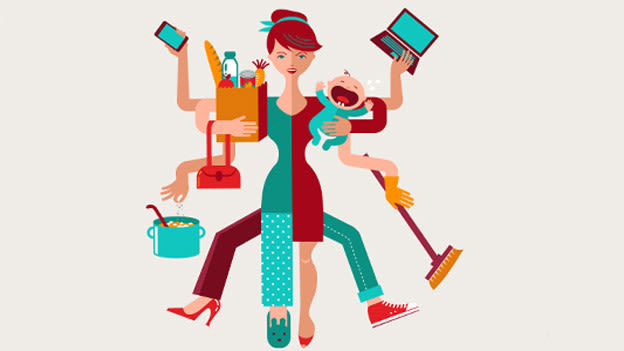Where men need to 'lean in'

Men hold power in the world of business, and there needs to be good reason for them to share it with women. And so men giving equal space to women in the workplace, needs to be complemented by letting them take a greater role at home
Last week I was at an ASSOCHAM conference at a posh Ashoka Road hotel in Delhi where its report Women Friendly Initiatives by Companies was about to be released. But the conference mainly grabbed headlines for Meneka Gandhi’s mocking of it at the venue itself- where the Women and Child Development Minister called such meets a “wastage of time” and pulled up corporates for doing little to enhance gender diversity except talk, while simultaneously abusing the law asking by filling up positions on boards with promoters’ wives, sisters and daughters.
I admired her courage for speaking out the truth, though I wished she had spent more time with ASSOCHAM leaders, corporate and NGO representatives at the venue to chalk out some solutions to the perpetually low representation of women, especially at senior levels. While women seem to be well represented in the echelons of higher education (the enrolment of women in higher education has increased significantly from 11% in 1951 to 43% in 2012), and hence at entry level positions in Corporate India, the numbers fall off as we move into middle and senior management. And it is not difficult to figure out why.
A 2011 research by Women Matter shows that 44% of Indian women in mid to senior level positions are strongly influenced by the notion that women must take care of the family, and it propels them to leave their jobs. To put things into perspective, in other Asian economies the situation is much better for women (17% for China, 26% for Indonesia and Taiwan) at least when it comes to such societal expectations. Globally, and especially in India, the notion of mothers being the primary care-giver to the child remains strong. Indeed, this popular notion makes the reverse true for men- fathers are rarely thought of as the natural care-giver to the child. In a recent Washington Post piece by a father of two children (I’m a dad. So why do people call me ‘Mrs.’? By Grant J. Schneider), the writer mentions his frustration at the many aspects of child care – from baby-product commercials to changing stations in public restrooms – that focus solely on mothers, and exclude fathers, almost instinctively it would seem.
If there is one thing I have understood in my work in the area of diversity management, is that it ultimately always boils down to a power game. Men hold power in the world of business, and there needs to be good reason for them to share it with women. And so men giving equal space to women in the workplace, needs to be complemented by letting them take a greater role at home. But traditionally in India, how many fathers have taken an active role in the child’s early stages of development? In their nutrition and health care? Or in their primary education?
My point is simple - till the woman remains the primary contributor at home, the man shall remain the primary contributor at work, and all affirmative action will ultimately come to naught, with women dropping out just when it starts to matter most. Sheryl Sandberg while advocating for women to “lean in” at the workplace, does not forget to remind us of the importance of letting men lean in at home. In a Yahoo News interview she said, “We also haven’t supported men as caregivers. … Women get discriminated against in the office; men get discriminated against when it comes to care.”
But how can this goal of men taking greater responsibilities at home be practically achieved? At a recent interaction with students at the Center for Diversity and Inclusion at KJ Somaiya Institute of Management and Research in Mumbai, I was glad that one of the students was quick to suggest one very effective yet simple solution - paternity leaves. Of the top five countries in UNDP’s Gender Equity Index, four provide paternity leaves by law - though fewer weeks compared to maternity leaves. Slovenia, which is 8th on the list provides near equality in parental leaves - 15 weeks for mothers and 12 weeks for fathers. Many organizations in these countries often go beyond what is mandated by law and offer equal leaves to both mothers and fathers. In India too, some companies have taken the first step. Godrej recently increased its paternity break to 10 working days or two weeks.
One hopes that like in the progressive Scandinavian countries, such policy shifts will eventually lead to a culture change where it is the norm for men to shoulder responsibilities at home just the way women do. Organizations are realizing how difficult it is for women who have taken a break from their career to reintegrate into the workforce. To enhance their own gender diversity as well as to tap into a latent talent pool, many companies in recent years have launched what are popularly called “Second Career” programs which help women on a break make a comeback. This is born out of an understanding that it is a challenge for women on a career break to re-enter the corporate world. However, can anyone imagine how difficult it would be for a man on a career break to make a similar return? The kind of and number of questions he would have to face? At a recent panel discussion of women leaders we hosted at Godrej on Women’s Day, one of the panelists from a major engineering firm was honest enough to mention how surprised she initially was when her husband suggested that he might go a career break for a while and give more time to the kids. But eventually she confronted her own stereotypes of what it means to be a man, and realized that doing so is as important as men giving up the stereotypes associated with women. If women can now take up combat positions in our military, men taking care of children at home should also not raise eyebrows.
Such culture change will be hard to come by - harder still in a country where patriarchy and misogyny are so deeply entrenched that when a female tennis super star marries a Pakistani man, it is her nationality that is publicly questioned, but not that of the man she marries. But there is certainly hope- hope that comes from the many Indian men themselves who realize that rigid gender norms hurt them as much as they hurt women. In Harjant Gill's documentary Mardistan (Macholand), that was recently screened at the Godrej India Culture Lab in Mumbai, he talks to four Punjabi men who have grown up in a society with strict notions of masculinity, but do not necessarily think of themselves fitting into any box. A father of twin girls worries about their safety, but also about their education and career; a gay man does not divorce his wife because he knows the social ostracism she would face as a result of that; a college student finds succor in Honey Singh’s song even as he struggles to emotionally understand and connect with his female colleagues- every single day of their lives they are redefining what it means to modern, Indian and male.
India is surely changing, and so are its men and women. Corporate India needs to not only embrace this change, but actively help in taking it forward through HR policies and practices that will help create a level playing field - both in the workplace and outside of it.
Disclaimer: This is a contributed post. The statements, opinions and data contained are solely those of the individual authors and contributors and not of People Matters and the editor(s).













